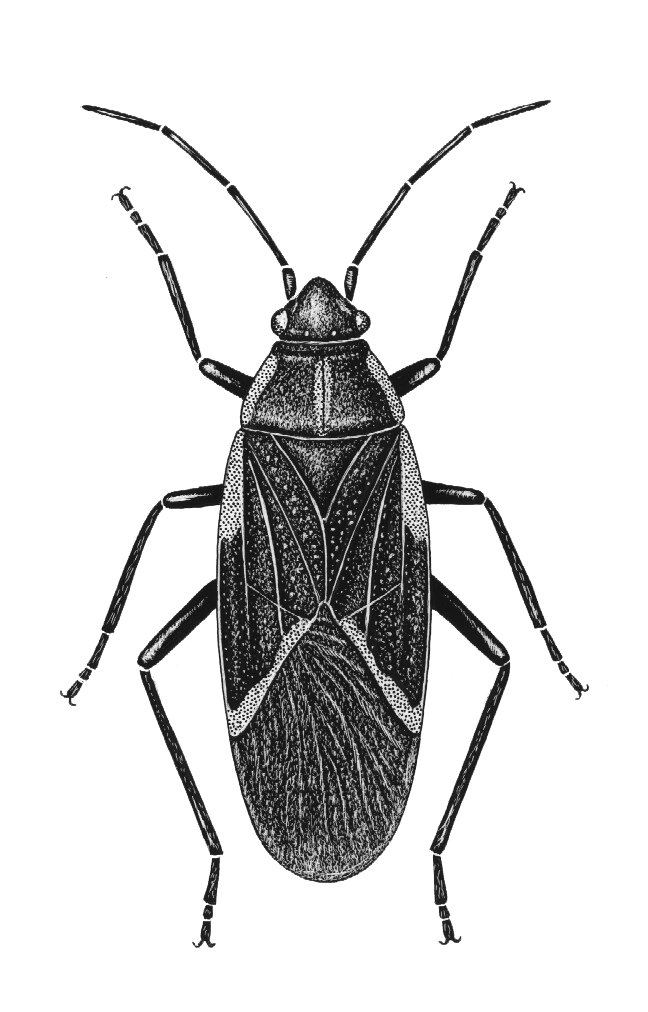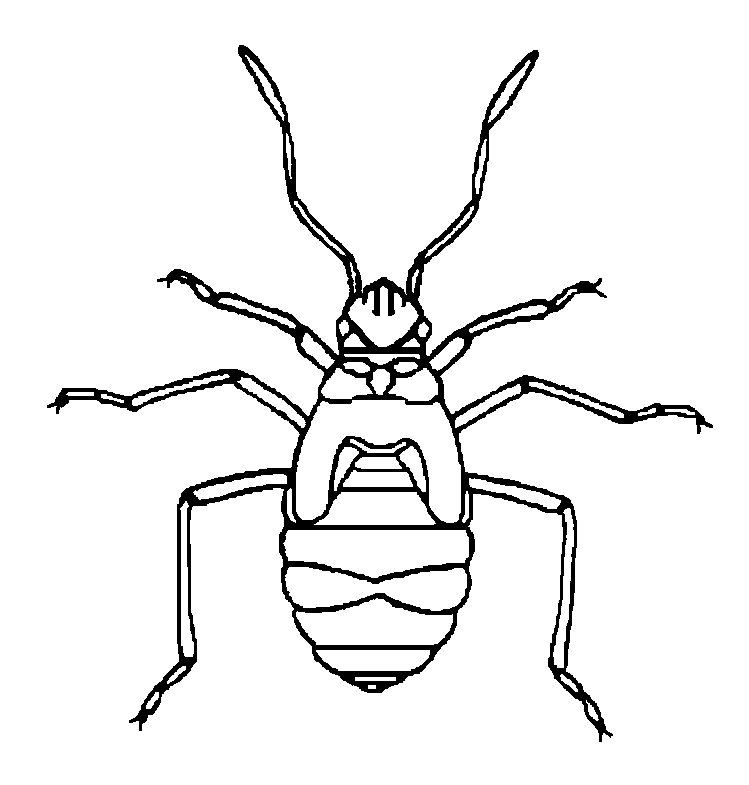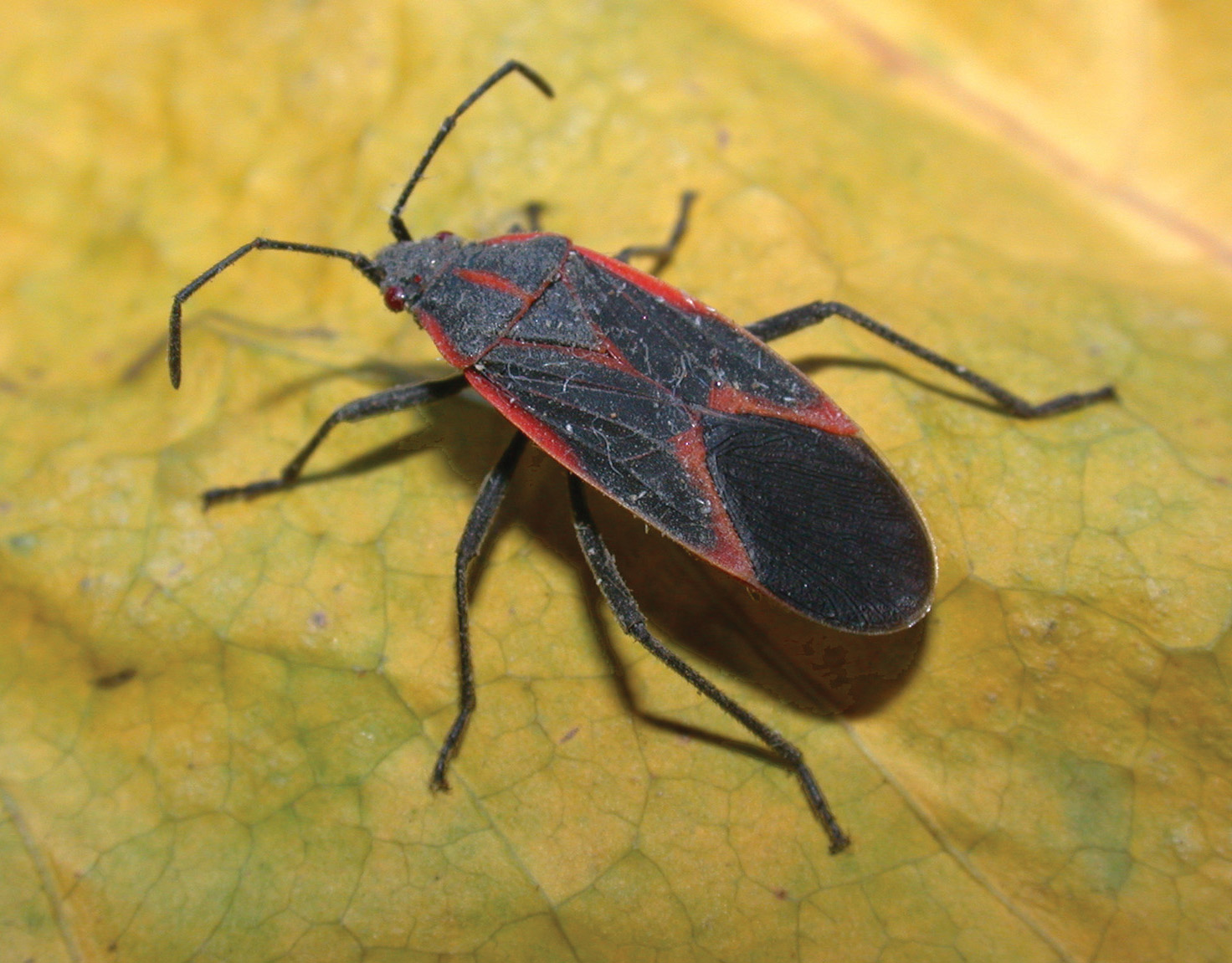LANDSCAPE & ORNAMENTALs
BOXELDER BUGS
Timothy J. Gibb, Extension Entomologist
If you want to view as pdf, click here
Boxelder bugs cannot bite or sting but may become nuisance pests when they invade homes. When fall temperatures begin to drop, adults search for protected cracks and crevices in which to pass the winter. Boxelder bugs near homes may squeeze into cracks in the foundation, windows, doors or under siding and shingles. During the coldest part of the winter the bugs remain inactive, but on warm sunny days in late winter or early spring they begin to return to activity and start leaving their winter shelter in search of egg-laying sites. Boxelder bugs may become trapped inside homes, and although they do not harm household furnishings, they can be annoying when they crawl or fly about the rooms.
Description
Adult boxelder bugs are approximately 1/2 inch in length, dark brown to black in color with conspicuous red markings on their backs. The young (nymphs) are bright red and wingless but are generally similar in shape to the adults.
Boxelder bug adult.
Boxelder bug nymph.
Life Cycle
Eggs are usually laid on the bark of female boxelder trees but can also be found on ash, maple, plum, cherry, peach, pear and other trees. The nymphs, which begin to hatch around June, have sucking mouthparts and feed by extracting juices from trees. Boxelder bugs feed and grow until midsummer when they develop into the adults which lay eggs for the second brood. Although large numbers of boxelder bugs can sometimes be observed on host plants, their feeding causes no appreciable damage to trees. In late fall, mature boxelder bugs will again migrate from the trees to seek shelter for the winter.
Boxelder bug. (Photo Credit: J. Obermeyer)
Control Measures
Boxelder bugs prefer the pistillate (seed-bearing) boxelders, avoiding the staminate ones. Nurserymen should therefore, propagate boxelders by taking cuttings from staminate trees only.
If only one or two trees of no particular value seem to be the source of boxelder bug problems their removal might prove best for long-term boxelder bug control. But remember that bugs can fly in from elsewhere in a neighborhood. The wholesale cutting of boxelder bug infested trees is therefore not recommended.
Spraying Infested Trees: One of the best controls for boxelder bugs is to spray infested trees during late summer while the second brood of bugs is still immature and concentrated on the trees. Carbaryl (Sevin) and permethrin (Spectracide Bug Stop, Eight) are labeled for this purpose.
Treating Outdoor Infested Premises: As boxelder bugs mature and leave the trees, they sometimes mass around foundation walls, along fence rows, at the bases of trees, evergreen shrubs, etc. Hot water (165o-180oF) applied directly to the clusters readily kills them.
Perimeter foundation treatments with chemicals also may provide good control if spray is applied to all sur-
faces over which the bugs crawl. Several gallons of spray are needed around the average home. Choose any of several insecticides labeled for ‘homeowner use’ as a foundation or outside perimeter treatment against occasional household invading insects.
Indoor Treatment: Remember that many times, infestations can be prevented or reduced by closing or sealing any openings through which the bugs can enter from the outside. This includes caulking small cracks and holes in the siding, window and door frames and screening ventilators. Broken doors, windows and screens should also be repaired. Do not forget to inspect entry ways into attics or crawl spaces as these may serve as staging areas for bugs to infest the remainder of the home later.
Once inside the home, boxelder bugs are difficult to control. Household sprays containing pyrethrins or resmethrin may give temporary control. A fly swatter and either a vacuum cleaner or broom and dust pan are often the best way to rid the home of these pests.
Boxelder bug adults and nymphs.
READ AND FOLLOW ALL LABEL INSTRUCTIONS. THIS INCLUDES DIRECTIONS FOR USE, PRECAUTIONARY STATEMENTS (HAZARDS TO HUMANS, DOMESTIC ANIMALS, AND ENDANGERED SPECIES), ENVIRONMENTAL HAZARDS, RATES OF APPLICATION, NUMBER OF APPLICATIONS, REENTRY INTERVALS, HARVEST RESTRICTIONS, STORAGE AND DISPOSAL, AND ANY SPECIFIC WARNINGS AND/OR PRECAUTIONS FOR SAFE HANDLING OF THE PESTICIDE.
February 2018

It is the policy of the Purdue University Cooperative Extension Service that all persons have equal opportunity and access to its educational programs, services, activities, and facilities without regard to race, religion, color, sex, age, national origin or ancestry, marital status, parental status, sexual orientation, disability or status as a veteran. Purdue University is an Affirmative Action institution. This material may be available in alternative formats.
This work is supported in part by Extension Implementation Grant 2017-70006-27140/ IND011460G4-1013877 from the USDA National Institute of Food and Agriculture.
1-888-EXT-INFO
www.extension.purdue.edu
Order or download materials from www.the-education-store.com






